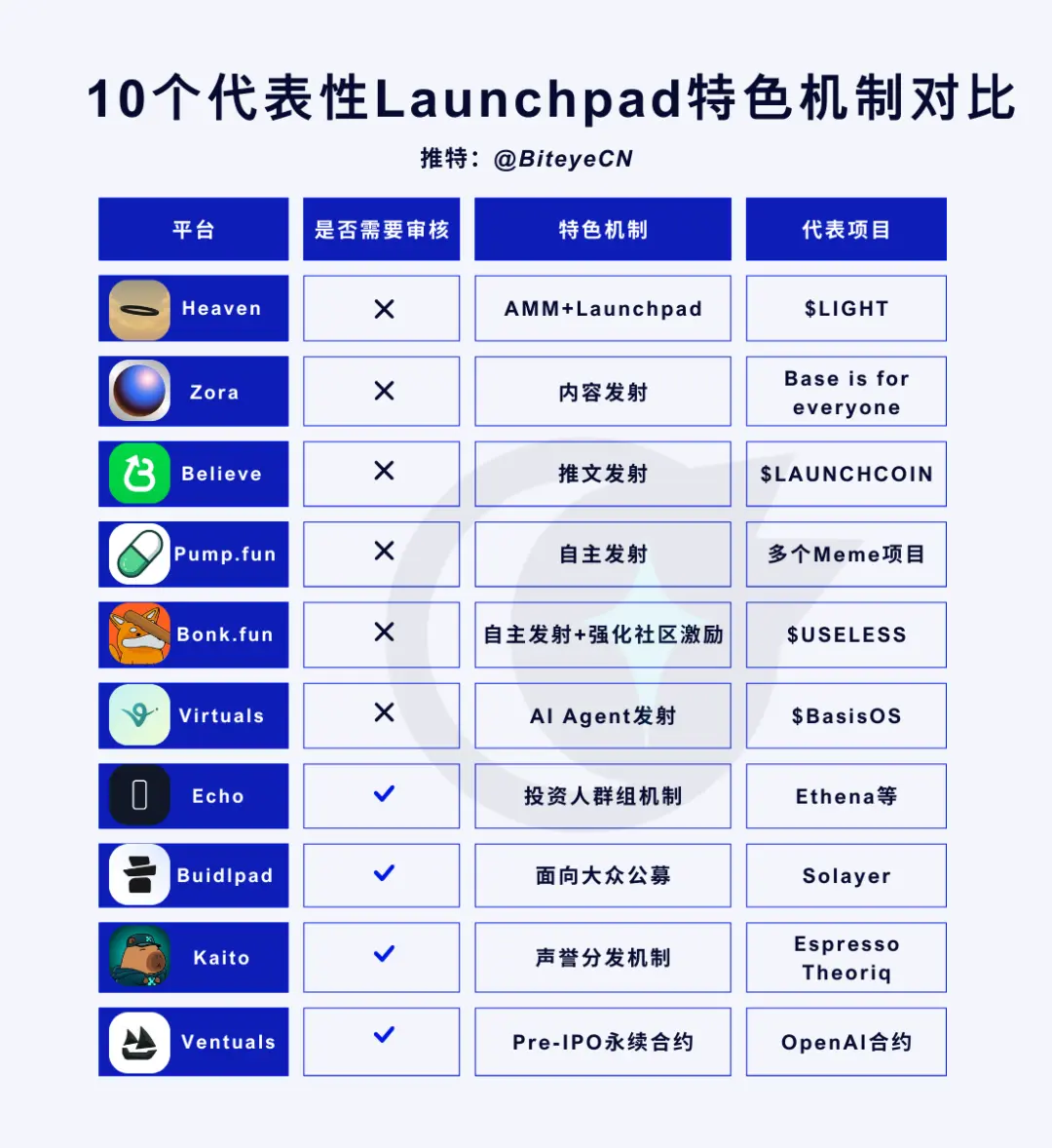Author: Biteye, Core Contributor Viee
Reprinted: White55, Mars Finance
From Meme to AI Agent, the exploration of Launchpad linked to traditional equity is also underway.
We selected 10 representative platforms, dissected their unique mechanisms, and discussed how retail investors can seize opportunities while avoiding pitfalls.

01. Permissionless Platforms
1. Heaven
Mechanism: Heaven is a newly risen AMM + Launchpad platform that integrates issuance and trading, with projects not needing to migrate to external DEXs. All transaction fees remain on the platform for buybacks and burning $LIGHT, allowing holders to share dividends directly. In contrast, while Pump.fun is profitable, it lacks such a feedback mechanism.
Performance: $LIGHT saw a continuous rise in the first week after its launch, with a market value exceeding 100 million USD. The ongoing buyback and burn mechanism greatly enhanced market confidence.
2. Zora
Mechanism: Zora is a social + creator economy protocol on the Base chain, where the core gameplay is that publishing content = launching projects. When you post a text or image, it will automatically launch assets.
Performance: $ZORA had a 10x increase over 20 consecutive days; in April this year, the official Coinbase Base chain account tweeted 'Base is for everyone,' leading to automatic minted assets. Many thought it was official, resulting in a rush that inflated the market value to 17 million USD, which then quickly fell back by 90%.
3. Believe
Mechanism: Believe originated from Clout, initially engaging in 'celebrity circles,' then shifting towards social assetization, bringing the ICM narrative to life. Users need only tweet with @launchcoin to automatically generate a project. Once the market value exceeds 100,000 USD, it will automatically list on trading platforms like Meteora.
Performance: $LAUNCHCOIN surged 50 times in 3 days, reaching a market value of 300 million USD. The previously named $PASTERNAK almost went to zero, but after renaming, it surged from 1 million to 22 million in 24 hours. Many projects on the platform have also provided retail investors with more than ten times the opportunities.
4. Pump.fun
Mechanism: Pump.fun is considered the pioneer of the on-chain asset issuance wave, explosively introducing the Meme gameplay. By uploading a name, logo, and introduction, contracts and initial liquidity pools can be automatically generated. The price uses a joint curve model; the more buyers there are, the higher the price. When the market value reaches a specified threshold, the smart contract will automatically migrate liquidity to external DEXs, seamlessly accessing a larger market.
Performance: As the number one permissionless platform, numerous well-known Meme projects have emerged from Pump.fun, which need not be elaborated further.
5. Bonk.fun
Mechanism: The BONK community launched a platform in April 2025, similar to Pump.fun, but emphasizes community dividends. A portion of transaction fees will be returned to BONK holders and ecosystem builders, strengthening community incentives.
Performance: The internet celebrity cat $HOSICO (peak market value of 60 million USD, 6x increase), $USELESS (peak market value nearly 300 million USD, over 10x increase). Overall, projects supported by communities are more likely to break through.
6. Virtuals
Mechanism: Virtuals focuses on the AI Agent track; users need to lock $VIRTUAL to create Agents and build pools. After reaching the joint curve threshold, they can 'graduate' and generate liquidity pools paired with $VIRTUAL.
Performance: After the initial hype faded at the beginning of the year, Genesis Launch reignited the market, with $VIRTUAL rebounding by 150% in a week, and the ecosystem following suit. The new project $BasisOS reached a market value of 5.5 million USD within 12 days of launch, with a maximum increase of 40 times.
02. Permissioned Platforms Required
Unlike 'no-threshold' platforms, these Launchpads will strictly screen projects, prioritizing quality.
1. Echo
Mechanism: Echo can be understood as an 'on-chain version of an angel investment alliance.' The gameplay is initiated by a lead investor who creates an investment group and shares project opportunities with the group, allowing everyone to co-invest, with the lead investor receiving a share of the profits. Echo requires users to undergo KYC verification via email, Twitter accounts, etc., making it more small-circle oriented.
Performance: Echo has facilitated financing for several popular projects, such as Ethena, Morph, Usual, Hyperlane, etc. After private placements, the development of these projects has been relatively stable.
2. Buidlpad
Mechanism: Buidlpad is a public offering platform launched by former Binance executive Erick Zhang at the end of 2024. Unlike Echo’s small-circle private offerings, Buidlpad has strict KYC requirements but is more public-oriented. In January, it launched its first project—the public offering of Solayer's LAYER.
Performance: Solayer oversubscribed by 5 times, with a 240% increase on TGE day; Sahara oversubscribed by 8 times, also increasing by 120% on TGE day. Next, @Lombard_Finance will also start community pre-sales on Buidlpad.
3. Kaito
Mechanism: In July, the Kaito team announced the launch of Capital Launchpad, a chain-based angel investment platform similar to Echo, but the allocation method is not based on speed but rather on on-chain holdings, social reputation, and other indicators.
Performance: The first project Espresso was valued at 400 million. The second project Theoriq was valued at 75 million.
4. Ventuals
Mechanism: Ventuals allows ordinary users to engage in Pre-IPO, but instead of issuing real stocks, it issues perpetual synthetic assets that track the company's valuation. Based on Hyperliquid's HIP-3 standard, it turns equity from unlisted companies into on-chain derivatives, trading like 'shadow stocks.' In contrast, PreStocks and Jarsy correspond to real stocks on a 1:1 basis, more closely aligned with traditional securities models.
Performance: As of August 20, the Ventuals project had a 24-hour increase ranging from 5% to 30%.
03. Launchpad Moat: Competing on Fairness, Thresholds, or Ecosystem?
From the previous cases, it's clear that Launchpad platforms are almost all 'one generation of versions, one generation of gods,' relying on two points: creating differentiated assets and retaining traffic on the platform. Based on this, there are several particularly critical dimensions:
1. Fairness: Heaven binds the interests of users and the platform through buybacks and burns; conversely, if controlled by bots and insider trading, the retail experience will collapse.
2. Threshold: The invitation system of Echo creates a small circle barrier, while Believe pulls people in through social network effects, making them hard to replicate.
3. Project Resources: Platforms that can continually attract good projects will form a 'stronger stronger' dynamic.
4. Model Innovation: Heaven's integration, Zora's content creation, and Believe's social triggers all provide first-mover advantages.
04. Retail Investor Strategy: How to seize Launchpad opportunities without getting buried?
1. First, consider preferences: If you enjoy speculation, you can play on permissionless platforms, where small investments may yield good returns; if you want stability, choose permissioned platforms where project quality is more guaranteed.
2. Control Position: Avoid going all in; high-risk positions should ideally not exceed 10%-20% of total funds.
3. Follow Market Rhythm: Meme, AI, Heaven, Zora are all rotating hotspots; when a platform suddenly becomes popular, there is often a short-term opportunity.
⚠️ Risk Warning: For reference only, not investment advice.






